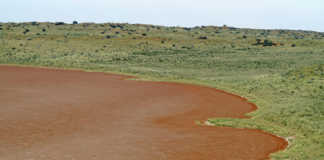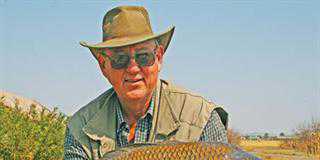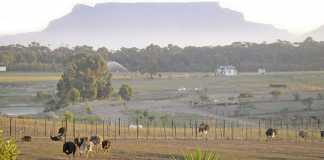Sharks have fascinated people since time immemorial. The mere thought that somewhere out there is still an ancient predator, capable of devouring one alive evokes in most people emotions so powerful and primitive that they are stripped of the last vestiges of rationality. Their attitude toward sharks can only be described as strange.
That the International Shark Attack File contains only 128 authenticated reports of shark attacks worldwide, while three times as many fatal criminal attacks take place in SA every week, matters very little. That only 10% of all sharks have the potential to harm a human, and that their chances are a thousand times higher of dying in a gruesome accident on the way to the beach than in the jaws of a shark once they get there, makes no difference. Stranger still is that despite all these emotions many will enter the shark’s world, protected only by a thin layer of suncream and a bikini.
Fossils with fins
Sharks are actually living fossils. After 350 million years they’re almost as old as the coelacanth and prime examples of a primitive, but highly sophisticated and successful design which has enabled them to survive almost unchanged for eons. They are still the top predators in the world’s oceans, and like all top predators their reproduction is very slow and their role in maintaining the balance in their environment is absolutely vital.
Large sharks have always represented a special challenge to many anglers. One day in the 1960s I witnessed a titanic battle between an exhausted angler and a giant great white shark on Durban’s South Pier. After three hours the shark, weighing almost 500kg, was eventually landed with only an old-fashioned bamboo rod and a huge wooden reel. Lately, shark fishing has developed into a new sporting craze. In the US the Quiznos Mad Fin Shark Series and similar tournaments are rivaling their Bass series in popularity and prize money. Only sharks longer than five feet qualify and if the hook is removed and the shark is able to swim away immediately, the points are doubled.
What I saw that day on the South Pier was not only one of the last giant sharks, but the end of the great shark fishing era in Durban. The legendary local Shark Fishing Club was disbanded soon afterwards because of the scarcity of big sharks in the area. This was not brought about by the relative small number of big sharks caught by those tough guys with their primitive tackle, but by the relentless killing of thousands of large sharks in nets along the KZN coast by an organisation with a double agenda. It started in 1952 when in the first year more than 550 big sharks were killed in Durban alone. Many of them were great whites and I knew it had to have an effect elsewhere.
For over 50 years a system of shark nets has been erected and maintained, first by local authorities, but since 1964 by the Natal Anti-Shark Measures Board to protect bathers from shark attacks. But this is not the whole story and for that we better start at the beginning.
In the beginning …
The inventor of the net system was a commercial net fisherman in a shark-infested area off the Australian coast. Tired of catching only small fish, he constructed a large-mesh net to catch big fish. After setting the net he returned the next day to find his net missing. Passing the same area two weeks later he was surprised to spot his marker buoys and on pulling his net in, found the remains of more than 100 large, decomposed sharks entangled in it. The struggling of the first shark that got caught in the net attracted other sharks to the vicinity which, in turn, got entangled too. This continued until the net was a mass of dead and dying sharks which sank to the ocean floor.
Decomposition allowed the net to float again after two weeks. News of the massacre spread around the world and led to the development of the well-known shark net system, which works in the same deadly way. Locally it was first implemented in Durban in 1952 and then systematically extended up and down the coast of KZN by what is now known as the Natal Sharks Board. The system was highly effective and had one purpose, and that was to entangle and systematically exterminate as many large sharks as possible that dared to venture closer to shore at night.
Inconsistent shark death numbers – go figure
The Sharks Board is notoriously non-obliging when it comes to divulging information. To find out how many sharks have been killed in the nets over the years is about as confusing as knowing the time when you’re wearing 10 watches. Every source that I could locate, that apparently quoted the board, gave a different figure, which varied from just over 2 000 to more than 50 000. I presume the probable conservative number of large sharks killed since 1952 is around 30 000.
But that’s not all – large numbers of other big fish, dolphins, turtles and even some baby whales have fallen victim. During the sardine run, especially, the mortality was astronomical. It is, for instance, known that during the 1971 run, 327 dolphins died in three days, and over 1 000 sharks were removed from the nets in 10 days. Many nets could not be located for weeks and the number of sharks and dolphins that decomposed in them is unknown. The consequences of exterminating the apex predators of the ocean on such a massive scale will, in the long run, be as inescapable as global warming and I saw some signs of it with my own eyes.
Relatively harmless large sharks like the ragged-tooth, whose reproduction is very slow, are the main predators of small dusky sharks, and pregnant females on their breeding migration are caught in the nets each year in large numbers. The duskies, which breed five times faster than their predators, which are now being exterminated, experienced a population explosion. They hunt the same prey and compete heavily with shad, which were still preyed upon by many other predatory fish. As a result the shad population plummeted so severely that human utilisation had to be curtailed drastically.
On 10 and 11 November 1984 the Natal Coast Anglers Union’s 77th annual competition took place during the height of the shad season along the North Coast beaches. Of the 2 067 fish landed, 92% were small dusky sharks. Although the shad population has recovered somewhat lately, their limited food supply retards their growth to such an extent that the large “blue shad” of yesteryear is very seldom seen nowadays.
Butterfly effect of shark slaughter
But the ripple-effect of this shark slaughter had its greatest impact in the Cape and the West Coast. Great whites migrate around our entire coastline and beyond, and their demise in KZN allowed the fur seals in many areas to multiply totally unchecked, and with the help of animal rightists, who prevented their culling, rendered the Cape almost fishless. Standing later at the 800 000-strong seal colony at Cape Cross, I realised that the problem is even greater in Namibian waters. Seal impacts on the available fish stocks were so devastating that the local fishing industry was on the verge of collapse – and in recent times it did.
It was therefore amazing that SABC’s 50/50 in a recent documentary condoned the activities of the Sharks Board and stressed the “environmental friendliness” of the board’s recently adopted “drop-line” system, after yielding to public opinion pressure that has turned against the killing of dolphins. The nets were never designed to keep the sharks away from the beaches but merely to kill them. So are the new “drop lines”, which are effectively a shallow-water, long-line fishing method that employs a series of huge hooks, suspended by buoys and baited with tuna or bonitos. It has the same killing function as nets but is just a much cheaper way to do it.
However, even more amazing is the Sharks Board’s audacity to state repeatedly on its website that they “are at the fore-front of conservation”, while they are in fact merely a commercial shark fishing operation whose activities have the fringe benefit of eliminating sharks that endanger bathers. They also state that they are “the only body of its kind in the world” and I believe them, because I’m sure no other fishing operation is paid tax money on top of the profit they make from their catch to carry out their activities.
One step forward, two steps back
That we must protect bathers goes without question, but I cannot believe that in the 21st century, with our technology that enables us to travel to outer space, we cannot find any other solution but the most primitive and barbaric to solve the problem. If in the Durban of 100 years ago the city engineers could find a civilised solution, that for 21 years protected bathers without killing a single shark, why can’t we?
We are hailed internationally as the first country to protect the great white shark which has become the icon of marine conservation worldwide. What would they say if it is disclosed what the Natal Sharks Board is doing under the noble cloak of bather protection? As field sports people we demand that the killing be stopped. We demand that research for alternatives be resumed and that the development of the Eddy Current Electrode System be revived. In the 1970s it showed so much promise in field tests at St Lucia when it blocked the entry of Zambezi sharks into the estuary. If perfected, it may bring just as much fame to our shores as the first heart transplant. Contact Abré J Steyn on 083 235 4822.













